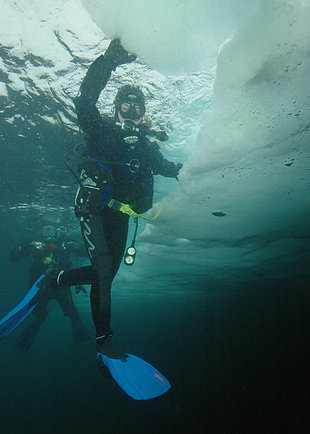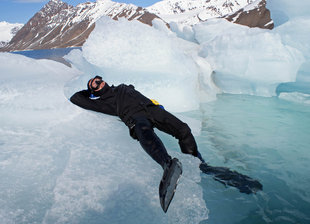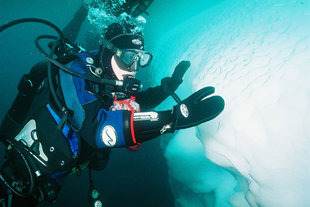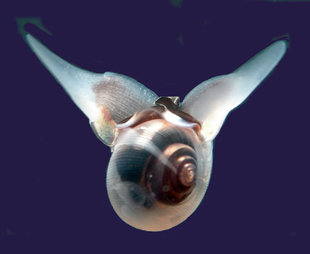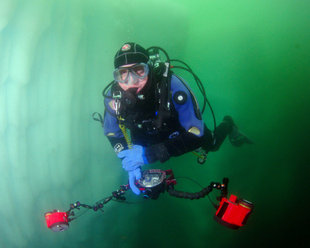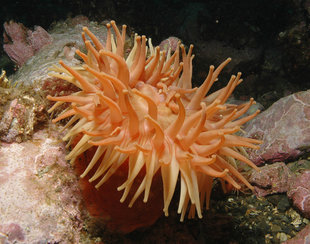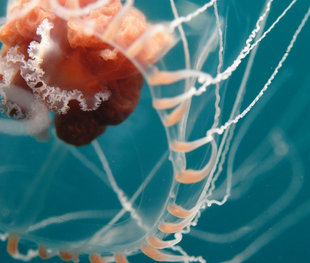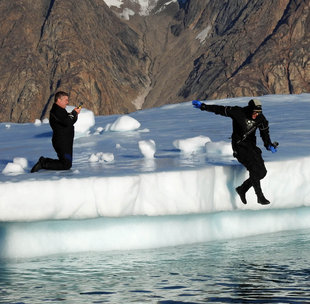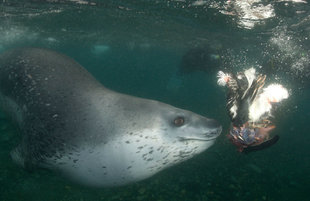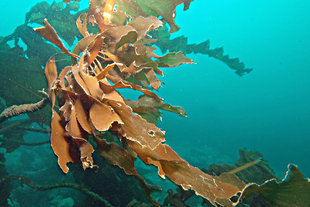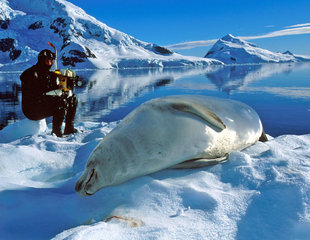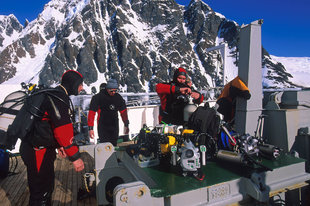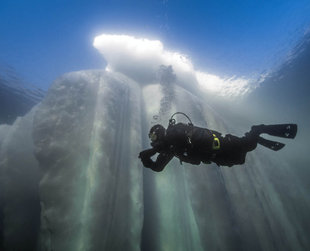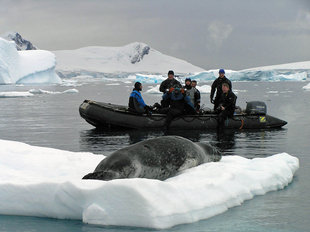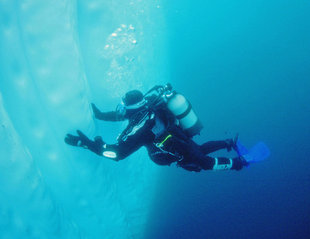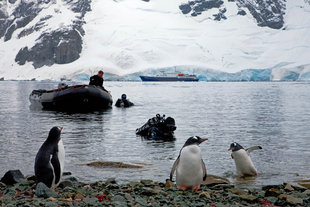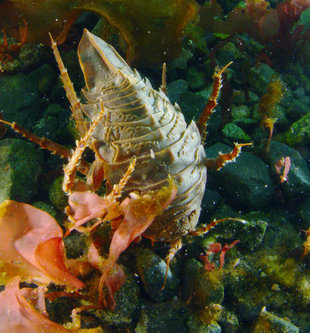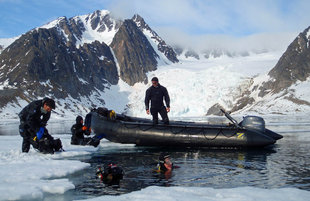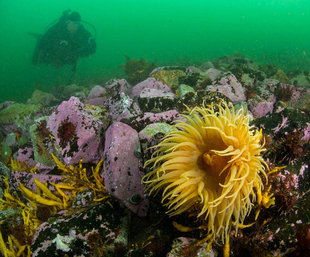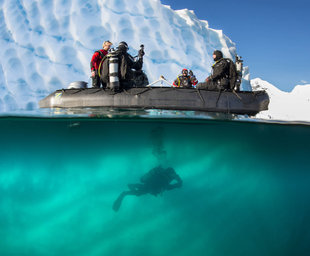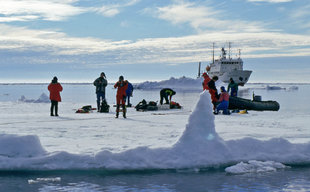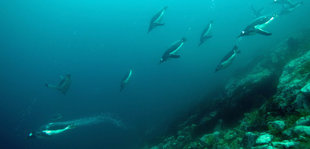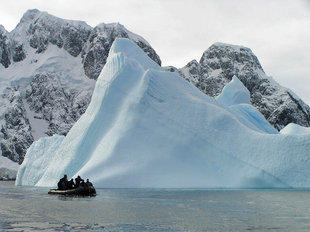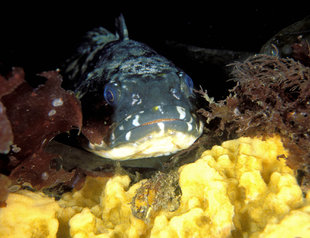Diving experience, qualifications and safety
Aqua-Firma's in-house dive team has almost 50 years of professional scuba diving experience: commercial divers, trained instructors and marine scientists. As dive guides in both the Arctic and Antarctica we are specialists in the field and as such can answer any question about your planned polar experience and kit, no matter how small or how technical.
Polar expeditions are not for beginner divers. You will need to be a very experienced diver and must be familiar with cold water and dry suit diving (at least 30 dives). Before departure you will have to show an internationally accepted diving certificate, diver's logbook and a statement from your doctor (not older than two years) stating that you are physically healthy to practice scuba diving.
Diving in these remote Polar areas is no more dangerous than normal scuba diving as long as one important rule is adhered to: Safety First! All divers looking for dangerous stunts or want to make deep dives are kindly asked to stay at home!!
There is no nearby decompression chamber in Spitsbergen, Greenland or Antarctica. Medical care in these polar regions is very limited as is the infrastructure. Although we have a doctor on board the vessel for first aid assistance, we cannot accept risky ventures from any of our divers.
If our dive master feels that a diver does not meet the necessary experience, they can decide to exclude the diver from the dive program (this decision will be made for that person's own safety). In this case, Aqua-Firma and associated operators cannot be held (financially) responsible and does not grant any claims. All divers are required to follow the instructions of the dive master and guides at all times. All participants are diving 100 % at their own risk, which is also the case during land based excursions.
Diving Operations and Procedures
You will plan at least one to two dives per day, but an exact number of dives cannot be given. It all depends on ice and weather conditions.
Check Out Dive
The voyage will start with a check-dive so all divers can get used to the cold water and try out their equipment and the number of weights they need. Before each dive, there will be a briefing about the location of the site, the weather and ice conditions and the procedure of the dive.
Dive Buddy
The dives will be done on a 'buddy system' basis. There will not be a dive guide in the water to accompany and lead the divers. The guides will stay on the surface for the divers' safety and they will check you 'out' and 'in' after each dive. The divers are expected to be experienced enough to read their compass, depth gauges and look after each other in order to have a safe dive.
Dive Equipment
Equipment on board
There is a dive compressor onboard (200 liters). Approximately 35 steel bottles of 12 litres 200 bar (DIN and Yoke connection) with two separate outlets and weights (hard). There are not any dive equipment rentals on board.
There is a large aft deck for preparing each dive (approx. 300 square meters). You do not need to store your dive gear in your cabin; there is plenty of room for your gear on the deck or in holds on the deck. Only take your regulator with you in your cabin.
Equipment you must bring
Don't bring any new equipment on this expedition that you have not already tested in the water and are very familiar with. The Arctic and Antarctica are not the place to test out new equipment. Please make sure that you have done at least 4 or 5 dives with your new equipment before coming on board. This is a list of equipment you will need to bring:
- Dry suit with hood
- Thick and warm underwater garment (2 sets)
- Drysuit gloves with extra under gloves
- 2 Freeze protected regulators, because we dive with special bottles with two
separate outlets
- Pressure gauge
- Stabilizing jacket or some kind of BC with quick release
- Depth gauge, watch or computer
- Compass
- Knife or scissors and a torch
- Mask, fins and snorkel
- Weight belt (weights available on board)
Each diver is expected to prepare his own equipment well in advance prior to each dive. Bring your own spare parts for your regulators and dry suit in case of leakage or damage. The diver will have to carry his own equipment in and out of the zodiac and sometimes up and down the gangway!
Frequently Asked Questions (FAQ)
How deep do we dive?
The maximum depth allowed is 20 metres / 60 feet. Many of the dive sites have slopes or faces that go much deeper than the 20m / 60ft max limit for the divers. Divers must act responsibly and show self discipline.
What is the average visibility?
A lot of pack ice often means clear visibility underneath and flat water. Little pack ice can often suggest the existence of a plankton bloom because there is more daylight and more swell. The ice and weather conditions are different every year, making it difficult to predict visibility in advance.
Will we be doing current and drift dives?
Currents exist at some dives sites but may also present anywhere at anytime and the environment is simply too complex to predict accurately. We will always check currents before entering the water.
We will not do drift dives. Drifting pack ice is a real hazard. If it comes in while divers are underwater then it can be very hard to see people if they surface in the middle of it. Icebergs should either be hard aground or floating in water well clear of brash or pack ice.
Do I need a full face mask?
This is up to the individual diver and depends on whether you are used to diving with a full-face mask or not. Many divers choose to dive without a full face mask. Vaseline is particularly helpful in protecting your face against cold and freezing waters.
What type of gloves are best?
You should use a minimum of 7mm wetsuit gloves. Otherwise we would recommend dry-suit gloves.
Why do I need two regulators?
We dive with two separate outlets (DIN and Yoke/A clamp connection), so in case of a free flow (e.g. due to freezing) at least one of your two regulators will be functioning.
Can I have one regulator with DIN valves and the other with ISO?
Yes, there are adaptors on board which we can put in the valve to connect with an ISO regulator. The DIN connection will fit without the adaptor.
Do I need to bring a waterproof bag to carry my smaller items?
It is handy to bring a waterproof bag to use while you are preparing your dive equipment on deck. In the zodiac we recommend that you only carry your necessary dive equipment.
What is the water temperature?
The water temperature is usually between 0 to -1.5 degrees Centigrade.

